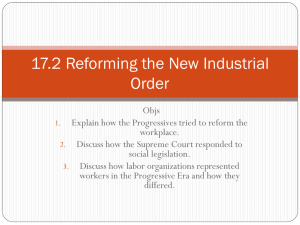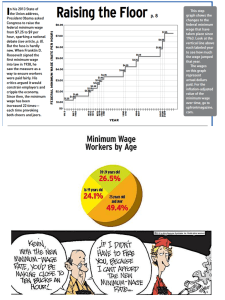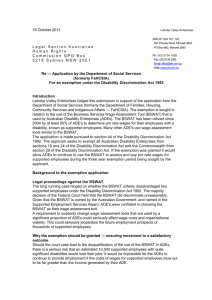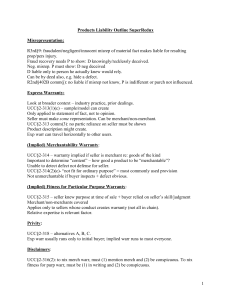Gender, Labour and Self
advertisement
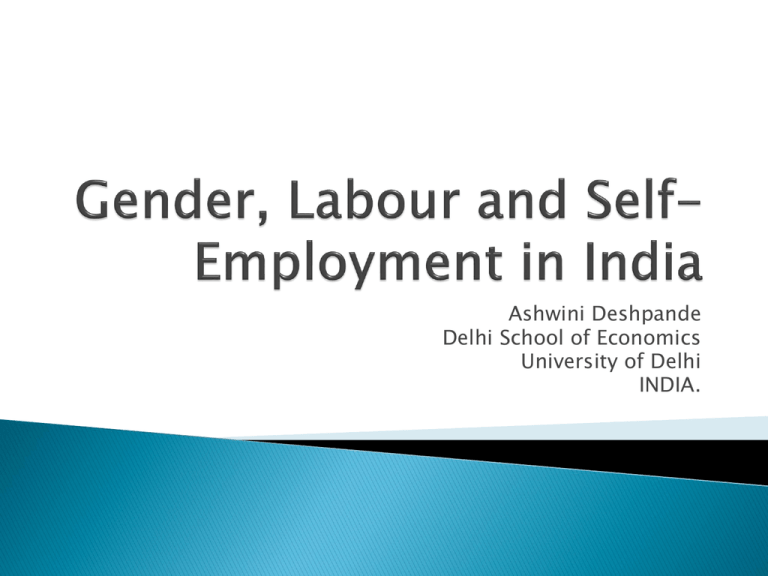
Ashwini Deshpande Delhi School of Economics University of Delhi INDIA. RURAL LFPRs by gender (age>=15) 100 90 80 70 60 50 40 30 20 10 0 1983 1993-94 1999-00 Male Female 2004-05 All 2009-10 Urban LFPRs by gender (age>=15) 100 80 60 40 20 0 1983 1993-94 1999-00 Male Female 2004-05 All 2009-10 Demand-based explanations: Low prody agriculture + excess supply of lab. Women’s paid lab needed only when men’s lab exhausted. Supply-side explanations: Socially ordained division of lab: women in reproductive activities within the household Discrimination-based explanation: employers discriminate against female workers, both in terms of hiring and wages. Measurement issues: lot of women’s work not counted as “productive” plus women often deny involvement in productive work. Share of women in regular wage/salaried employment lower than that of men (rural: 4% female WF in RWS (vs. 9) & urban: 39 vs. 42) (2009-10) Correspondingly, share of women in casual workers & self-employment higher than men. Rural: 79% women in agri; Urban: 53% women in tertiary 2009-2010: NSS 66th round emp. survey Urban: RWS average daily wage: Rs. 364.95. Rural: Rs. 231.59 Rural Male: Rs. 249.15; Rural Female: 155.87 => ratio of 0.63. Urban Male: 377.16; Urban female: 308.79 Ratio of 0.82 * Casual labour: 0.67 (Rural) and 0.58 (Urban) Blinder-Oaxaca Decomposition (Khanna 2012): Strong evidence of labour market discrimination Gender Wage Gap (log) QR Coef. OLS Coef. 1 0.9 Log Wage Gap 0.8 0.7 0.6 0.5 0.4 0.3 0.2 0.1 0 0 10 20 30 40 50 60 Percentiles 70 80 90 100 This plots the log of the gender wage gap at each of the 99 percentiles using NSS 20092010 wage data for those reporting regular wage/salaried employment (Khanna 2012). The “Sticky Floor” effect is evident: wage gaps are much larger at the bottom of the distribution and decline almost monotonically till the top of the wage distribution. The average gap (given by the OLS coefficient) is instructive, but misses out on this nuanced picture. 0.9 0.8 0.7 0.6 0.5 total_differential 0.4 characteristics 0.3 coefficients 0.2 0.1 0 1 2 3 4 5 6 7 8 9 1 0.8 0.6 Total 0.4 Charecteristics Coefficients 0.2 0 -0.2 0 0.5 1 Registered SSI sector: 3rd MSME Census (2001-2) Women- owned enterprises 10.01% Women -managed enterprises 8.36% States with higher than all-India proportions States with higher than all-India proportions Arunachal Pradesh Arunachal Pradesh 20.08 24.8 Assam 14.11 Assam 13.46 Karnataka 14.49 Karnataka 12.87 Manipur 16.69 Kerala 19.76 Meghalaya 33.59 Manipur 16.01 Mizoram 25.35 Meghalaya 33.02 Sikkim 25.17 Mizoram 26.71 Tamil Nadu 14.83 Nagaland 14.04 Sikkim 17.01 Tamil Nadu 13.33 Overlap of ownership and management 65% of women-owned enterprises are managed by women 2% of male-owned enterprises are managed by women Percent women employed by gender of ownership and management In women-owned enterprises In men-owned enterprises 57.56 6.17 In women-managed enterprises In men-managed enterprises 68.48 6.1 owned Manuf of wearing apparel managed 40.3 48.76 13.06 12.09 7.3 7.25 Manuf of fabricated metal prodts, except machinery 4.51 3 Manuf of chemicals and chemical products 3.73 3.25 Manuf of other non-metallic min products 3.69 2.64 Manuf of furniture 3.47 2.97 Retail trade, repair of household goods 2.92 2.51 Manuf of wood and straw products 2.68 2.3 Mauf of food prodt and bev Manuf of textiles Women are not a homogenous category. For example: overlap of caste and gender. Earlier evidence: greater taboos on upper caste women, who were materially more prosperous – trade-off between prosperity and immurement. LFPRs among SC-ST women higher than UC. Now: trade-off vanishing. Dalit women worst off: triple burden of gender, caste and class. With greater legal differentiation, fewer women work, own or run businesses (WBL, 2012) South Asia (except SL) one of the 3 regions where explicit legal gender differentiation in accessing institutions and in using property is most common. Moreover, benefits such as paternity leave absent. Lack of autonomy in interacting with government institutions Access to judicial system Getting a job: differences in work hours, restrictions by industry, poor antidiscriminatory laws, with even poorer implementation Benefits (e.g. maternity leave): India: employer pays (rather than the government), raising the cost of hiring women. India: gender disc in lab mkt => wage gaps and differential access to wage employment, sometimes exclusion of women. Discrimination inefficiencies and lower growth (Esteve-Volart, 2004). Individuals belonging to a group which is discriminated against face higher interest rates in credit markets. => lab mkt disc credit market discrimination Esteve Volart (2004): An increase of 10% in the F/M ratio of managers would increase PC NDP by 2% An increase of 10% in F/M ratio of total workers would increase PC NDP by 8%. => Gender inequality in the access to working positions is a bigger break on growth than gender inequality in the access to managerial positions.




